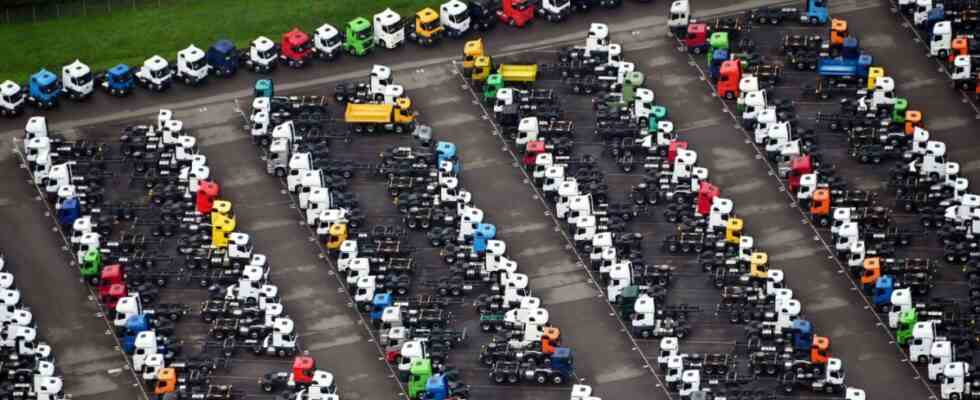If you talk to trucker wife Karin Rådström about her work, then it’s about a lot of money, about jobs, about technology. And after a few minutes at the latest, a pretty big dilemma that everyone in the supermarket should soon feel. Rådström is the boss of Mercedes-Benz trucks and a board member of Daimler trucks, you guys sell tens of thousands of trucks a year all over the world. Huge machines that effortlessly pull up to 40 tons, but burn 25 liters, more like 30 liters of fuel per 100 kilometers.
But business cannot go on like this, says Rådström. “We can’t stay with diesel forever!” The well-being of the planet is at stake. The 43-year-old, who has two children, is relieved of his worries. In addition, quite unemotionally: for reasons of climate protection, politicians are demanding a reduction in greenhouse gases, i.e. ultimately a change to trucks that run on hydrogen or battery power instead of diesel.
We know this from cars: From the year 2035, new cars in Europe will in all probability no longer be allowed to emit any pollutants. In the case of trucks, the rules are not yet quite as strict. In Germany, the focus is initially on halving CO2 emissions by the end of the decade, compared to the 1990 level. But the change is more difficult, and the effort is even greater. “Trucks with the new types of drive will never reach the cost level of diesel trucks,” says Rådström. “As consumers, we will feel the decarbonization in our wallets.”
800,000 heavy trucks drive through the country every day, and almost everyone on the roads is annoyed by them. They transport everything you need or think you need: cheap stuff from China, groceries, steel. The trucks are the supply system of our prosperity.
An electric truck costs at least twice as much as a diesel model
But they are getting more expensive: Today, an electric truck is two to three times more expensive to buy than a diesel truck. If a heavy diesel tractor costs a good 100,000 euros – if you buy a few dozen and negotiate properly – the electric version is more like 300,000 euros. For long distances – 500 kilometers and more – there are still none to buy, from any manufacturer, not even from Tesla, who are also trying to do this. Technologically, everything has been developed “in essence”, says Rådström, but Mercedes wants to offer a long-distance e-truck in 2024. But for the foreseeable future, without a government subsidy, such a vehicle will remain unprofitable.
The batteries in particular drive up the costs, so everyone in the industry is hoping for lower operating costs: E-trucks would be cheaper to maintain and energy costs, so the expectation. But now the price of electricity is going up and putting a spanner in the works. In addition, the distribution of energy is an unsolved problem: This is already difficult with car traffic, heavy trucks require special high-performance charging stations. The manufacturers are trying to build such an infrastructure in Europe together with energy suppliers, says Rådström. But: “It’s not fast enough.”
The top manager sees part of the solution in fuel cell technology. The company’s calculations show that it is financially worthwhile “to set up hydrogen filling stations parallel to the truck charging stations” from which the trucks draw imported green hydrogen. In view of the increasingly evident difficulties with the power supply, this controversial technology is now even “more relevant than it was a year or two ago”. In the second half of the decade, the group wants to offer suitable vehicles.
Karin Rådström knows what she’s talking about: she has a truck driver’s license.
(Photo: Daimler Trucks & Buses Communica; Daimler Truck/Daimler Truck AG)
They are words that matter. The Swede, who now lives in Stuttgart, is not only responsible for the figures and products of one of the most important truck manufacturers in the world, but also worked for competitor Scania. And she has a truck driver’s license.
“Unfortunately, Ms. Rådström is right,” says Dirk Engelhardt, spokesman for the board of the Federal Association of Road Haulage, Logistics and Disposal (BGL). The situation is becoming increasingly tense for the transport companies in view of the drive turnaround and ultimately also for the consumer. “You can use an example to illustrate this,” says the chief logistician, who used to drive a truck himself: “A small pot of yoghurt that costs maybe 25 or 30 cents today will probably be between two and five cents more expensive.” The freight forwarders work with narrow margins of between one and three percent. They would therefore have to pass on cost increases to the retail groups “and of course they pass it on to consumers”.
Another challenge is not even considered in the yoghurt calculation, says Engelhardt: the lack of drivers, which is independent of diesel, hydrogen or batteries. Around 100,000 truckers are currently missing in Germany. For some time now, the market has started to react to this – and to pay higher wages. It is currently a good 3000 euros per month, it should soon rise to 4000 euros, some in the industry even expect 6000 euros. Again a few cents more, converted to the cup.
Now Engelhardt has nothing against fair pay for hard work. But that makes the expensive switch to environmentally friendly drives even more difficult. Although the environmental friendliness should be questioned anyway, according to the lobbyist. The electricity comes too often from gas and coal-fired power plants, too rarely from wind and solar systems. “Consumers are led to believe that they have to pay more for climate protection, but even after the engine conversion, transport will not be as green as hoped for in the foreseeable future.” Another dilemma.

